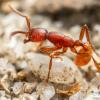Yes, one must assume that age and cuticular hydrocarbon profile of queen, diet, ambient air and soil temperatures, overwintering conditions, diurnal lengths must be physiological and environmental factors contributing to alate production and synchronized nuptial flights of disparate colonies over a geographical area. Housed containerized conditions cannot simulate these broader environmental conditions. Alate production itself may be associated with colony size and age, queen status (age/physiology) and feeding conditions since much energy must be devoted to production of larger alate larvae. One can therefore have alate production but not in synch with local colonies.
Edited by PurdueEntomology, August 23 2023 - 10:31 PM.















